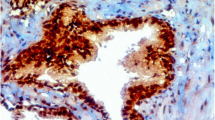Abstract
p27(Kip1), cyclin D3 and Ki67 are the markers of DNA damage and cell proliferation. The goal of the current study was to analyze expression of the markers in benign and malignant prostate cancer tissues. Activity of p27(Kip1), cyclin D3 and Ki67 was immunohistochemically evaluated in different cells of BPH, prostate cancer (PCa) and hormonally treated prostate cancer (HTPCa) tissues. The tissue samples were derived by means of TURP or radical prostatectomy. Intensity of the expression was compared between the groups, and association was sought with clinical parameters. Total expression of p27(Kip1) was significantly higher in BPH as compared with PCa. Epithelial marker expression was higher in HTPCa than in PCa. Intensity of the expression in epithelial, vascular and ductal cells was negatively associated with the tumor stage and Gleason grades. Total Ki67 activity was positively correlated with patient age and serum PSA level. There was significantly higher expression in PCa and hormone-escaped PCa (HEPCa) as compared with BPH. Epithelial and vascular marker expression was positively associated with tumor stage and Gleason grades. There was a positive correlation between cyclin D3 and serum PSA level. With the increase of Gleason grades, cyclin D3 expression increased significantly. Expression of p27(Kip1) negatively correlated with Ki67 and cyclin D3, while the latter two markers correlated positively. p27(Kip1) is down-regulated, whereas Ki67 and cyclin D3 are up-regulated in PCa. Intensity of the markers’ expression is associated with tumor stage and grades. Hormonotherapy of PCa causes activation of p27(Kip1). HEPCa is characterized by increased Ki67 expression.




Similar content being viewed by others
References
Poulos CK, Daggy JK, Cheng L (2005) Preoperative prediction of Gleason grade in radical prostatectomy specimens: the influence of different Gleason grades from multiple positive biopsy sites. Mod Pathol 18:228–234
Petrylak DP, Tangen CM, Hussain MH et al (2004) Docetaxel and estramustine compared with mitoxantrone and prednisone for advanced refractory prostate cancer. N Engl J Med 351:1513–1520
Thomas GV, Schrage MI, Rosenfelt L et al (2000) Preoperative prostate needle biopsy p27 correlates with subsequent radical prostatectomy p27, Gleason grade and pathological stage. J Urol 164:1996–1997
Faussillon M, Monnier L, Junien C, Jeanpierre C (2005) Frequent overexpression of cyclin D2/cyclin-dependent kinase 4 in Wilms’ tumor. Cancer Lett 221:67–75
Mirtti T, Kallajoki M, Aaltonen M, Alanen K (2001) Cyclin A and Ki-67 with DNA content in benign and malignant prostatic epithelial lesions. Anal Quant Cytol Histol 23:229–239
Halvorsen OJ, Haukaas S, Hoisaeter PA, Akslen LA (2001) Maximum Ki-67 staining in prostate cancer provides independent prognostic information after radical prostatectomy. Anticancer Res 21:4071–4076
Sobin LH, Wittekind C (eds) (2002) TNM classification of malignant tumours, 6th edn. Wiley-Liss, New York
Chkhotua AB, Gabuzi E, Altimari A et al (2003) Increased expression of p16(INK4a) and p27(Kip1) cyclin-dependent kinase inhibitor genes in ageing human kidney and chronic allograft nephropathy. Am J Kidney Dis 41:1303–1313
Freedland SJ, de Gregorio F, Sacoolidge JC et al (2003) Preoperative p27 status is an independent predictor of prostate specific antigen failure following radical prostatectomy. J Urol 169:1325–1330
Pollack A, DeSilvio M, Khor LY et al (2004) Ki-67 staining is a strong predictor of distant metastasis and mortality for men with prostate cancer treated with radiotherapy plus androgen deprivation: radiation therapy oncology group trial 92–02. J Clin Oncol 22:2133–2140
Ojea Calvo A, Mosteiro-Cervino MJ et al (2004) The usefulness of Ki67 expression in the biopsy specimens, to predict the biochemical progresion of the prostate cancer after radical prostatectomy. Actas Urol Esp 28:650–660
Kuczyk M, Machtens S, Hradil K et al (1999) Predictive value of decreased P27 Kip1 protein expression for the recurrence-free and long-term survival of prostate cancer patients. Br J Cancer J 81:1052–1058
Cheng L, Lloyd RV, Weaver AL et al (2000) The cell cycle inhibitors p21WAF1 and p27KIP1 are associated with survival in patients treated by salvage prostatectomy after radiation therapy. Clin Cancer Res 6:1896–1899
Zeng L, Rowland RG, Lele SM, Kyprianou N (2004) Apoptosis incidence and protein expression of p53, TGF-beta receptor II, p27Kip1, and Smad4 in benign, premalignant, and malignant human prostate. Hum Pathol 35:290–297
Gandour-Edwards R, Mack PC, deVere-White RW, Gumerlock PH (2004) Abnormalities of apoptotic and cell cycle regulatory proteins in distinct histopathologic components of benign prostatic hyperplasia. Prostate Cancer Prostatic Dis 7:321–326
Dreher T, Zentgraf H, Abel U et al (2004) Reduction of PTEN and p27KIP1 expression correlates with tumor grade in prostate cancer. Analysis in radical prostatectomy specimens and needle biopsies. Virchows Arch 444:509–517
Inoue T, Segawa T, Shiraishi T et al (2005) Androgen receptor, Ki67, and p53 expression in radical prostatectomy specimens predict treatment failure in Japanese population. Urology 66:332–337
Zellweger T, Ninck C, Bloch M et al (2005) Expression patterns of potential therapeutic targets in prostate cancer. Int J Cancer 113:619–628
Acknowledgments
This study was supported by grants from GlaxoSmithKline and GMP Georgia.
Author information
Authors and Affiliations
Corresponding author
Rights and permissions
About this article
Cite this article
Nikoleishvili, D., Pertia, A., Trsintsadze, O. et al. Expression of p27(Kip1), cyclin D3 and Ki67 in BPH, prostate cancer and hormone-treated prostate cancer cells. Int Urol Nephrol 40, 953–959 (2008). https://doi.org/10.1007/s11255-008-9350-y
Received:
Accepted:
Published:
Issue Date:
DOI: https://doi.org/10.1007/s11255-008-9350-y




